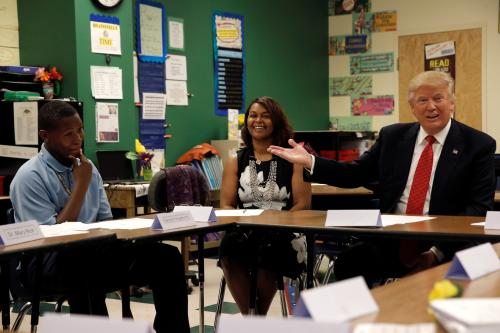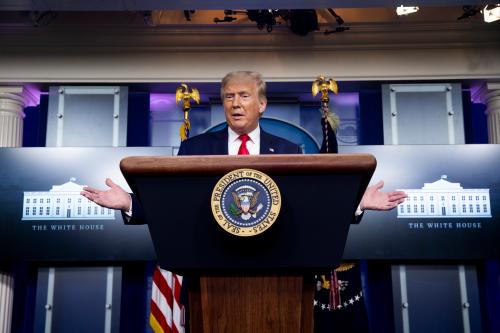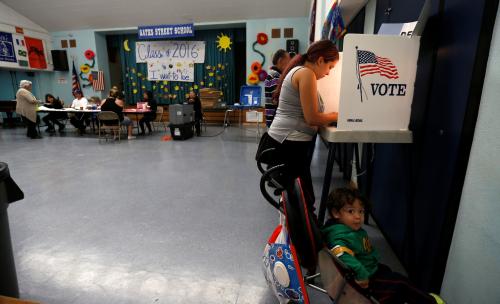On the cover of The Economist on Feb. 4, 2017, the bright red headline read: “An insurgent in the White House.” In this context of an “insurgent” President Donald Trump, K-12 education is subject to a critical reassessment in the current White House. I offer a few observations on Trump’s first quarter in the presidency and what this signals about the direction of federal education policy.
The insurgent presidency attempts to scale back the federal role
Trump’s White House aims to significantly repurpose the federal role in K-12 education. The administration has dismantled key initiatives that were associated with the Obama administration. At this point, Trump’s proposed initiatives constitute a critical reassessment, but do not yet amount to an all-out dismantling of the federal role in K-12 as embedded in the long-established “marble cake” federalism. In the FY18 budget proposal, for example, the Trump administration maintains federal funding for major categorical programs for high-needs students, such as Title I and the Individuals with Disabilities Education Act. The Every Student Succeeds Act (ESSA) reporting requirement on performance among student subgroups remains a central federal focus.
It is too early to tell whether the Trump administration plans to fundamentally reconstruct the terms of federal engagement in public education, which have been largely framed since the Great Society era of the Lyndon Johnson administration. But the administration could be headed in that direction, considering that the first quarter of the Trump presidency has included the following education policy initiatives:
- Scaling back federal direction and shifting substantial decisionmaking to state and local government;
- Proposing substantial budgetary reduction of the U.S. Department of Education, such as programs in college and career access, arts, health, after-school programs, teacher education, and technology;
- Expanding federal support for a broad portfolio of school choice, including charter schools, vouchers for parents to enroll their children in public and private schools, federal tax credit scholarship program, and magnet programs;
- Easing possible entry of for-profit providers in K-12 education;
- Placing limits on federal capacity to promote equal education access, such as limiting the scope of Title IX enforcement; and
- Reducing investment in data and research infrastructure.
School choice as a federal priority
The appointment of U.S. Secretary of Education Betsy DeVos signals a strong commitment to school choice from the Trump administration. To be sure, this is not the first time a U.S. president advocated for school choice: Ronald Reagan was a strong proponent of school choice, but was unable to gain much congressional support. President George H. Bush was receptive to the notion of charter schooling, when AFT President Albert Shanker first proposed it in the 1980s. Further, President Bill Clinton popularized charter schools with federal startup funding, a position endorsed by both presidents George W. Bush and Barack Obama.
But unlike his predecessors, Trump hopes to scale up his school choice initiatives with a large infusion of federal funds. He first made this promise on the campaign trail, pledging $20 billion in federal funding. In his first presidential appearance before a joint session of Congress on Feb. 28, 2017, Trump echoed his campaign promise, proposing a bill that provides federal funding for school choice.
The new governing landscape seems supportive of school choice expansion. First, the administration can rely on the state policymaking authority under ESSA. Second, with two-thirds of the states under one-party Republican control in both houses, Trump’s school choice initiative has received favorable response in several state houses. Third, charter schools have continued to receive steady, favorable preference among parents in minority communities (though some minority groups, including the NAACP, have grown more critical). It was a calculated move on Trump’s part to mention that school choice will benefit African-Americans in his joint session address last month.
Possible rollback on the federal role in equity and accountability
Historically, equity has been a key justification for federal involvement in K-12 education. Since the civil rights movement and the Great Society agenda, federal education programs have been designed to promote equal educational opportunities for all students. Title I of the Elementary and Secondary Education Act of 1965 was part of the president’s War on Poverty. Since the presidency of Reagan, the federal government has broadened its focus to include performance-based accountability.
The Trump administration is ready to reverse the federal-state dynamic on both equity and accountability, and the Trump White House has an opportunity to do so in the current political climate. First, the 2015 iteration of ESSA rebalanced federal-state relations by granting states much more control over school accountability and improvement strategies compared to the No Child Left Behind era. Second, the Republican-controlled Congress recently used the Congressional Review Act to further reduce federal authority under ESSA by repealing the “Accountability and State Plans” regulation published by the Obama administration. DeVos now has the opportunity to grant even more power to states as they implement ESSA.
Third, the federal government may also choose to withdraw from some of the equity-oriented practices. DeVos is reviewing whether the Department of Education’s Office for Civil Rights will continue an effort that began in 1968 to collect biennial data on schooling opportunities and quality in public schools throughout the country.
Challenges and opportunities ahead
The Trump administration has embarked on an ambitious agenda in K-12 education. While the new governing landscape may facilitate the president’s disruptive agenda, the administration’s effectiveness depends on several conditions. First, the Trump White House has to reorganize the federal administrative capacity behind a coherent set of policy goals. Failure to do so limits any president’s ability to accomplish their goals.
Second, the president leads within the framework of separation of powers. One central implication is that the executive branch has to work with Congress on the budget. It remains to be seen whether Trump’s education initiatives will be hindered by inter-branch rivalry or intra-party disagreement, or fostered by Republican unity behind his education agenda.
Further, federalism often takes on its own dynamics. While states and districts engage in competition and innovation, the federal government must address disparity and inequity. These policy challenges await the insurgent presidency to demonstrate its governing effectiveness.
Looking forward, ESSA implementation will evolve across the states during the Trump presidency. States may utilize their ESSA authority to advance innovative practices and turn states into “laboratories of democracies.” On the other hand, the gap in reform capacity among states may widen, creating the need for a more assertive federal role. Another possibility is that states may devolve accountability responsibility to local districts, which may create implementation tension between states and districts. Given differences in capacity and culture, states will likely chart a variety of reform paths that will inform the next phase of state-federal relations in the context of the Trump presidency.







Commentary
Redefining the federal role in public education: The 1st quarter of the Trump “insurgent” presidency
March 27, 2017